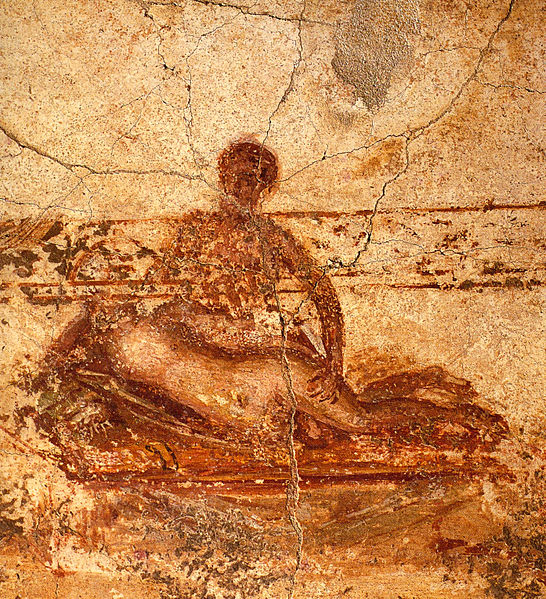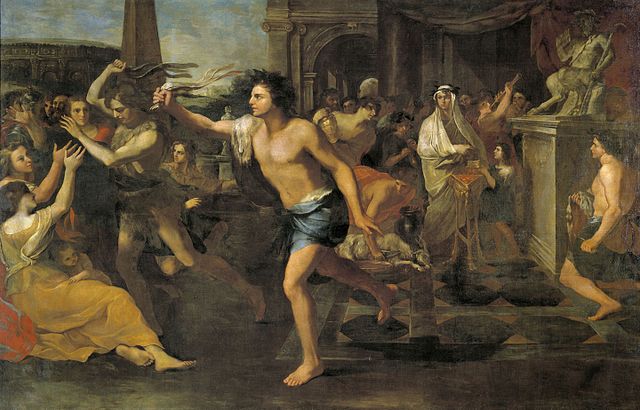Ancient Roman sexuality
Published on 16 May 2018Reading time: 14 minutes
The topic of ancient Roman sexuality brings to mind a society of unbridled sexuality but is this modern perception of Roman sexuality correct? To address this question, we need to distinguish between facts and fiction and take into account the cultural, religious and legal aspects of sexuality in Ancient Rome.

Apodyterium - Scene II CC-PD-Mark |
Cultural aspects of ancient Roman sexuality
When archaeologists discovered the ancient city of Pompeii in the 18th and 19th century, they discovered a lot of sexual art deemed obscene and later hidden from view by the public in the Secret Cabinet of the National Archaeological Museum of Naples. This sexual art included paintings of erotic scenes, phallic oil lamps and other objects deemed pornographic. Fascist dictator Benito Mussolini wanting to recreate a new Roman empire saw the Pompeii excavations favorably but the presence of sexually explicit material was... problematic. For example, the Suburban Baths of Pompeii had erotic wall paintings featuring group and oral sex scenes suggesting that people back then would not have found such erotic scenes offensive 1.
To understand ancient Roman sexuality, we first need to understand how Roman society functioned. Roman society was first and foremost a patriarchal society where men dominated and set the rules be it in business, politics, legal matters or even religion. Women had fewer rights than men, they could not vote or hold public office, and they were under the control of their husbands or fathers (patria potestas). Men could have sexual relationships with partners deemed permissible including slaves or prostitutes and that was not considered adultery 2, whereas women couldn't. Sexuality for men was related to ideas of masculinity and male domination.
Ancient Rome was also a slave society meaning that a large number of people were slaves. A Roman citizen's political liberty (libertas) included the right to preserve the integrity of his or her own body, meaning that he or she could not be beaten, flogged or sexually abused 3. Slaves in contrast were regarded as property and could be used by their masters for sex. Masters also controlled the sexuality of their slaves as more children from their slaves added to their wealth. However, slaves could not be used for sex by other Roman citizens unless their masters hired them out for sex 4.
Prostitution in Ancient Rome
Prostitution was commonplace in the ancient Roman world and was legal throughout the Roman Empire in all periods5. Slavery probably contributed to it: prostitutes were either slaves or freedwoman, but mostly slaves, and had to be registered with the aediles, an office of the Roman Republic. They were categorized as infames along with actors, actresses, dancers, and gladiators noting that actresses were also assumed to be prostitutes. Infames served the pleasure of others and "were tarnished by exposure to the public gaze" 6. They enjoyed few legal protections and could face corporal punishment such as flogging by Roman authorities, a form of punishment forbidden for Roman citizens.Prostitutes actually appear in the erotic art of the Suburban Baths of Pompeii suggesting that prostitution was commonplace and well accepted. Until the late Republic, Roman baths had a section for women or different schedule for men and women, while during the Roman Empire, baths, like the Suburban Baths of Pompeii, were mixed. However, women bathing naked with men were probably lower-class women or infames such as entertainers or prostitutes. Emperor Hadrian (reign: 117 – 138 AD) banned mixed bathing, but the ban seems not to have endured7.
Homosexuality in Ancient Rome
Romans did not think in terms of sexual orientation (heterosexual vs. homosexual) and there was no equivalent for the word "homosexual" in Ancient Rome. It was socially acceptable for a Roman male to have intercourse with both men and women as long as he took the active role. Taking the passive role was looked down upon and was seen as taking the role of the woman, threatening a Roman man's sexual integrity and even liberty as a free citizen. Permissible male partners included slaves, infames (e.g. actors) and male prostitutes. Roman men who practiced homosexuality often preferred younger males between the ages of 12 and 20 noting that sex with young male citizens was prohibited.Was homosexuality more prevalent in Ancient Rome than it is today? Even though no historian can really answer this question, the answer is probably not. There were probably a good number of men who abhorred homosexuality, but in the prevalent patriarchal and slave-oriented culture of Ancient Rome, where some human beings were considered as mere objects, it would have been seen as just another form of sexual activity and... a matter of taste. Even though it is hard to understand today, what was more important was the role (active or passive) and status of the Roman male.
Roman orgies
When dealing with the subject of ancient Roman sexuality, massive orgies (from the Latin word orgia and Greek word ὀργάω, to arouse, swell, ripen) involving sexual depravity and debauchery also come to mind. But were orgies so commonplace in Ancient Rome? The main accounts come from Roman historian Suetonius in Lives of the Twelve Caesars and he is probably the reason why this idea has stuck for so long. Many scholars however agree that his descriptions probably contain a lot of exaggerations and rumors. It is true that Roman emperors such as Tiberius and Caligula did organize and participate in such orgies. At his magnificent royal residence of Capri, the brutal emperor Tiberius lived a life of extraordinary debauchery: he would bring the most beautiful young women (and men) from the four corners of the Empire to satisfy his sexual urges. Young Caligula would be a witness to all this sexual depravity, which probably affected his psychology.Group sex, sex parties, orgies were probably something reserved to a very small section of the upper class though. Most Romans lived ordinary lives, had to work hard to make ends meet and would probably not want to tarnish their family's reputation by being involved in such activities. Roman orgies are also often confused with the religious festivals such as those in the honor of Bacchus or Lupercus, both fertility gods, which involved a lot of nudity. Sometimes these festivals went out of control and, as a result, were later reformed by the Roman pontifices. For example, the kind of worship of Bacchus which often involved debauchery was criminilized in 186 BC to be replaced by a reformed version.
Roman law and sexuality in Ancient Rome
Roman law played a major role in shaping ancient Roman sexuality and evolved throughout the Republic and Empire. A Roman husband could have sex outside of marriage as long as his partner was considered sexually available, i.e. was a prostitute, a slave, or an infamis such as an actress. He committed adultery (adulterium) only when he had sex with another Roman citizen's wife or unmarried daughter. In contrast, no infidelity was acceptable for a Roman woman and first-time brides were expected to be virgins. It is worth noting that divorces, including for adulterium, were common in Ancient Rome and that people did re-marry.As we previously pointed out, Roman law protected the Roman citizen from sexual misconduct (stuprum) whereas Roman slaves and non-citizens did not enjoy the benefits of libertas. This meant that Roman citizens, male or female, were off-limits while sex with slaves or prostitutes was easily available. According to Roman law, rape could only be committed against a citizen in good standing. A woman who worked as a prostitute, as an actress or as a dancer lost her social standing and became an infamis. By making her body publicly available, she had lost her right to be protected from sexual abuse or physical violence 3.
As far as homosexuality is concerned, the Lex Scantinia of c. 149 BC prosecuted adult male citizens who took a passive role in sexual relations with other men or who had sex with freeborn male minors. The law did not prohibit homosexual behavior as such, but punished male citizens taking the passive role or committing sex crimes (stuprum) against freeborn male minors.
At the beginning of the Roman Empire, Rome's first emperor, Augustus (reign: 27 BC – 14 AD), passed laws (the Leges Juliae) in 18-17 BC as part of his program to restore the mos maiorum or traditional social norms, following a period of instability, while consolidating his political authority. This goes to show that Rome was traditionally a conservative society and not the modern imagination of a sex-crazed society. The Leges Juliae main objectives were to increase the population by encouraging marriage and having children and to restore the morality of the upper classes. The laws had a section pertaining to adultery, the Lex Iulia de adulteriis (translation: "Julian Law concerning acts of adultery") which was primarily directed at married women who committed adultery. The law made adultery a public matter and punished adultery with banishment and with the confiscation of part of property. Husbands and fathers had the right to kill the partners in adultery under certain circumstances even though this was rarely carried out. Augustus actually applied this law to his very own daughter Julia who was banished and sent to the island of Pandateria.
Ancient Roman sexuality and Christianity
Roman religion was overall more open to sexuality than Christianity. It does not mean however that it encouraged depravity but rather that it promoted fertility.

Andrea Camassei c. 1635 CC-PD-Mark |
For example, Lupercalia was a religious festival taking place on February 15 whose purpose was to expel the evil spirits and to purify the city (februum means purification in Latin), thereby bringing health and fertility. This festival involved some people running half-naked with thongs of goat-skin in imitation of the god Lupercus.
Floralia was another religious festival in honor of the fertility goddess Flora, the goddess of flowers and of the season of spring held between April 28th and May 3rd. This religious festival involved prostitutes who danced naked and fought in mock gladiator combat. There were also a number of gods linked to sexuality such as Liber, the god of viticulture and wine, fertility and freedom, the god Cupid (Cupido), the god of desire, erotic love, attraction and affection, the imported Greek fertility god Priapus protector of livestock, fruit plants, gardens and male genitalia, the phallic marriage god Mutunus Tutunus who promoted marital sex. A lot of the sexual art found by archeologists was related to Roman superstitions linked to the Roman religion. For example, the phallus, found in the form of an amulet or wind chimes, was supposed to have powers to ward off the evil eye and other malevolent supernatural forces 1.
It can be said that all these gods promoted life and fertility as opposed to death. It does not mean that all Roman religion promoted sex. Vesta was the virgin goddess of the hearth, home and family, and the guardian of the Roman people and the religious festival Vestalia held between June 7th and 15th was one of the most important in Ancient Rome. Vesta was rarely shown in human form but was personified by the fire of her temple in the Forum Romanum. The Vestal Virgins were full-time priestesses of Vesta who tended the sacred fire at the hearth of the temple. They had to observe absolute chastity for 30 years. A Vestal Virgin who violated her vow of chastity was entombed alive in a ritual that resembled a Roman funeral. Her lover was executed. Therefore, one of the most important goddesses in the Roman religion was a virgin goddess.
The spread of Christianity throughout the Roman empire, its acceptance with the Edict of Milan in 313 AD under Constantine the Great (reign: 306–337 AD), and its adoption as the state religion with the Edict of Thessalonica of 380 AD, had a dramatic impact on Roman customs and sexuality and impacts our culture to this day. Many of the Roman religious traditions either faded away or were banned altogether. As we previously pointed out, Vesta was a very important goddess for the Romans. She was so important that her cult continued well into the fourth century AD until it was forcibly disbanded by emperor Theodosius I in 391 AD. Pope Gelasius I (494-496 AD) considered Lupercalia a vile festival and sought to abolish it. The senate protested and insisted that Lupercalia was essential to Rome's well-being and safety. Then Pope Gelasius suggested with disdain to senator Andromachus that they should celebrate it themselves and run around naked if they thought that this rite was salutary.
The gradual disappearance of all the pagan cults and the establishment of Christianity as the main religion, led to gradual changes in beliefs and attitudes towards sexuality. Some historians believe that the modern perception of Roman society as a decadent society comes in fact from early Christianity. Christians viewed celibacy as ideal and sex as inherently sinful, redeemed somewhat only if it took place within marriage 8. Christianity put the emphasis on monogamy and expanded the definition of adultery to include married men having sexual relations with anyone other than their wives, including slaves or prostitutes. "But since sexual immorality is occurring, each man should have sexual relations with his own wife, and each woman with her own husband." (Corinthians 7:2). Under Emperor Justinian I (reign: 527 – 565 AD), laws against adultery, albeit less strict for men, could also be applied to husbands who cheated on their wives 9.
Even though Christian Rome was more conservative than pagan Rome when it comes to sexuality, especially the sexuality of men, it also gave more rights to women. For example, under Justinian I, married women were no longer put to death for adultery and were rather sent to a convent. Wronged husbands were no longer required to divorce their wives as with the Lex Iulia de adulteriis and had the right to pardon them. With the previous Roman law, if the wronged husband did not divorce his wife he could be charged with pandering (lenocinium in Latin from the word leno, "pimp").
With Christianity, the official attitude toward prostitution became chillier. Constantine I, the first Christian emperor, accepted it as a fact of life but taxed prostitutes. Theodosius II prohibited fathers from making a profit from their daughters, and slave owners from prostituting their slaves. Emperor Leo I banned prostitution outright and Theodora, a former prostitute herself, attempted to put an end to it as soon as she became empress 9 10.
Even though the prosecution of homosexuality as a general crime began before the adoption of Christianity, laws against homosexuality became tougher under the Christian Empire. Men taking the passive role were punished by burning by the end of the 4th century AD. Under the Theodosian Code (Codex Theodosianus), the punishment for "a man coupling like a woman" was "death by sword". In the 6th century, under emperor Justinian I, all homosexual sex, passive or active, no matter who the partners were, was declared "contrary to nature" and punishable by death.
Conclusion
Despite the modern perception of Roman society as a mecca of vice, the Romans were not any more sexually different than a number of modern societies. Their view of sexuality through art or religion was different than ours without inferring that they were more promiscuous. Overall, the Romans were actually more restricted in their sexuality that in most modern Western societies. Roman society was male-dominated and men had access to sex with prostitutes or slaves but sex outside of marriage with other Roman citizens was very limited and often severely punished. The sexuality of citizen women was even more restricted and forbidden outside of marriage while the sexuality of slaves was tightly controlled. Therefore, the modern perception of Roman society as a sex-crazed society is not accurate and most average Romans would probably have been dumbfounded by the prevalence of sex in modern Western societies.
Interesting facts about ancient Roman sexuality
|
SOURCES
- Looking at Lovemaking: Constructions of Sexuality in Roman Art 100 BC – 250 AD (John R. Clarke, University of California Press, 1998)
- Concubinage and the Lex Iulia on Adultery (Thomas A.J. McGinn, Transactions of the American Philological Association, 1991)
- Prostitution, Sexuality and the Law in Ancient Rome (Thomas A.J. McGinn, Oxford University Press, 1998)
- Stuprum: Public Attitudes and Penalties for Sexual Offences in Republican Rome (Elaine Fantham, 2011)
- A Companion to the Roman Empire (David S. Potter, John Wiley & Sons, 2009)
- Roman Sexualities (Judith P. Hallett, Princeton University Press, 1997)
- Bathing in Public in the Roman World (Garrett G. Fagan, University of Michigan Press 1999, 2002)
- Sexuality and the Jesus Tradition (William Loader, Eerdmans, 2005)
- The Emperor Justinian and the Byzantine Empire (James Allan Stewart Evans, Greenwood Publishing Group, 2005)
- The Secret History (Procopius of Caesarea, Penguin Classics, 2008)
YOU MAY ALSO LIKE
Return from Ancient Roman sexuality to Homepage

